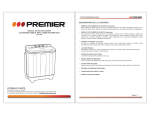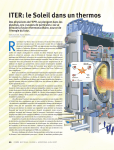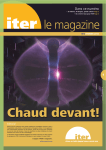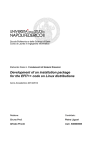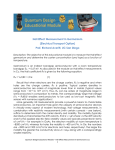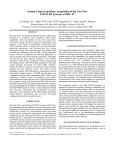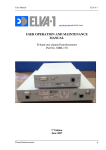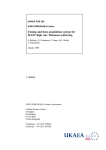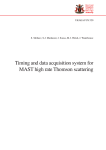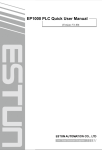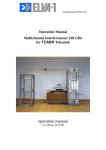Download XGC-0 User Manual Scenarios for Running XGC Simulations
Transcript
XGC-0 User Manual 1 June 2006 Scenarios for Running XGC Simulations There are basically three ways to run XGC simulations to compute the shape of the density and temperature pedestal at the edge of H-mode discharges in tokamaks. The physics and results associated with the three scenarios are described in detail in the paper by C.S. Chang, Seunghoe Ku and H. Weitzner in Physics of Plasmas 11, 2649 (2004) [1]. Neoclassical Ion Solution This scenario produces a quick solution to demonstrate neoclassical ion effects without the effect of neutrals and without following the time development of the pedestal buildup. First, turn off the influx of neutrals (neu col mode = 0) and start with a very narrow pedestal (small values of eq den ped width, eq tempi ped width, and eq den tempe width). The pedestal will then relax to a steady state solution. The results of this scenario are described in Section 5 of Physics of Plasmas 11, 2649 (2004). During the relaxation, a radial electric field will build up in the pedestal due to a radial current density. When the plasma reaches steady state, the flux-surface-averaged radial current density will go to zero hjtotal,r i = hjion,r i + hjelectron,r i = 0. Since the ion radial current density is much much larger than the electron radial current density driven by neoclassical effects, we have hjion,r i ' 0. The ion radial current density consists of three parts hjion,r i = hjdriven,r i + hjclassicalpolarization,r i + hjneoclassicalpolarization,r i. The term hjclassicalpolarization,r i is computed using textbook analytic expressions and it is needed to recover the geodesic acoustic mode structure. The hjdriven,r i and hjneoclassicalpolarization,r i terms, which are generally much larger than the hjclassicalpolarization,r i term, are computed numerically within the XGC-0 code. The ion loss mechanism that produced the radial electric field is described in detail in Reference [2]. Effect of Neutrals The second scenario produces a more physically realistic solution by starting with a very broad low pedestal (large values of eq den ped width, eq tempi ped width, and large values of eq den tempe width) and using an influx of neutrals (typically neu col mode = 2) to build up the density pedestal. The results of this scenario are described in Section 6 of Physics of Plasmas 11, 2649 (2004). The influx of neutrals can be specified by either a source strength or an edge neutral density or an edge recycling rate. If a recycling rate is used, set the recycling rate 1 (neu recycle rate) less than 1.0. (If the recycling rate is set greater than or equal to 1.0, the code is likely to run out of memory and crash.) WARNING: The user must specify enough memory for neutrals (at least 10 MB), greater than the charged particle memory, or the code can crash. During the course of a simulation using this scenario, the flux-surface-averaged radial current density will rapidly decrease to small values and then hover around zero. Fluctuations around zero will be smaller when more charged particles are used in the simulation. The radial electric field will increase to its nearly steady state value and then hover (with fluctuations) around that value. Usually, about 50 ion transit times around the tokamak are sufficient to reach nearly steady state conditions. Note that electrons are produced by neutral ionization events and, on closed flux surfaces, each electron remains on the flux surface where it was born. WARNING: If too few neutrals are used in the simulation the statistics will be poor for energy conserving ion-neutral collisions. Effect of Turbulence A simple model for turbulent transport is available in the XGC-0 code and a more complete 3-D turbulence simulation will be available in the XGC-1 code. For the third scenario, the simple turbulent transport model is used in the XGC-0 code. The results of this scenario are described in Section 7 of Physics of Plasmas 11, 2649 (2004). In the XGC-0 code, it is assumed that the particle transport driven by turbulence in ambipolar. The turbulent diffusion coefficient is written in the form Dturbulence = ∆2 /τdecorrelation where the user specifies Dturbulence and sets ∆ much smaller than the pedestal width (typically ∆ ∼ ρi ), and the code computes the corresponding value of τdecorrelation . In response to this turbulent particle diffusion, electrons and ions carry out a random walk along the radius with a net flux down the density gradient. WARNING: It is found that the XGC-0 code is numerically unstable when Dturbulence is a function of the radius. In effect, a radially uniform value of Dturbulence can be thought of as a spatially averaged flow shear rate. General Comments Charged particles are initially loaded uniformly in space. The density profile is produced in the XGC-0 code by giving lower weight to particles in regions of space where the density is lower. In the absence of collisions, the weight for each particle is fixed in time. The neutral influx can be adjusted to maintain the overall charged particle number even when some charged particles are lost to the walls. A linear interpolation is used to compute the charged particle density at zone centers. Consequently, the effective size of each particle cloud is determined by the spatial zone dimensions. Since a four point averaging technique is used is used around each gyro-orbit, the charged particle size perpendicular to the magnetic field is related to the gyro-radius. 2


